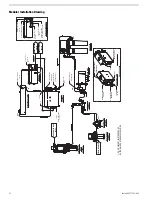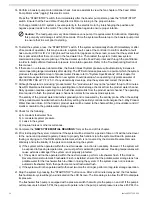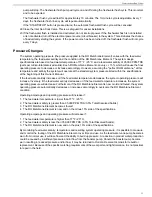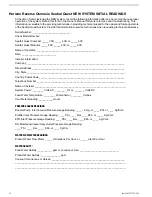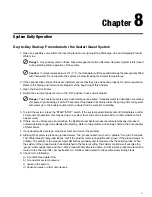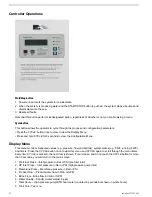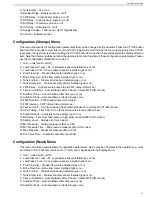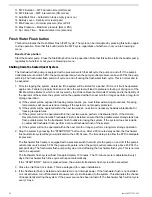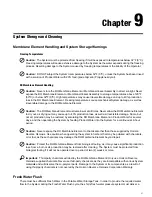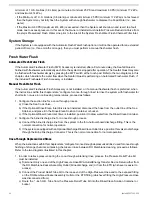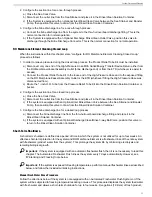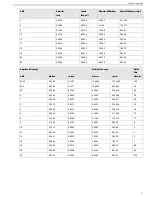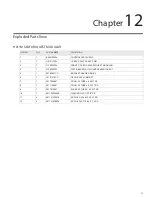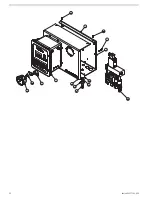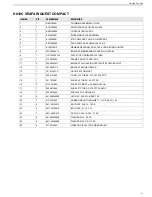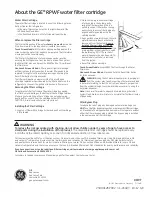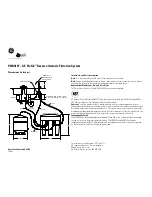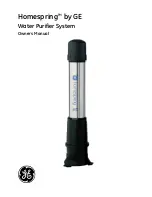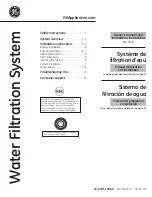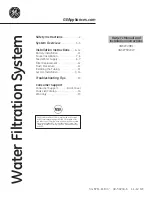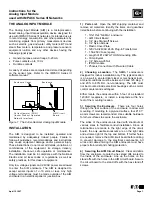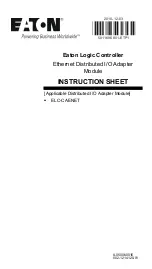
f) Remove the freshwater flush charcoal filter bowl; drain and clean the inside of the bowl. Replace the freshwater
flush charcoal filter element with a new Horizon Reverse Osmosis freshwater flush charcoal filter element,
and replace the bowl with new element back onto the housing.
The system may now be left unattended for up to 3 to 6 months. With ideal conditions, including a relatively new
RO Membrane Element, a clean system prior to storage, cool temperatures and no leakage of storage chemical
within the system, it provides protection for up to 6 months. Adverse conditions may provide less protection.
Evaluate these factors before determining the proper interval between repeated rinsing and storage periods.
RO Membrane Element Cleaning Procedures
Important:
Do not arbitrarily clean the RO Membrane in a new system. If a new system experiences low
production or high salinity, then the system should be operated for up to 48 hours continuously to clear and
saturate the RO Membrane Element product water channel. If a new system still experiences low production
and or high salinity after 48 hours of continual operation, then contact the factory.
Important:
The membrane element requires cleaning from time to time. Biological growth and salt
accumulation eventually make replacement necessary. The frequency of required cleaning depends on the
amount of production loss and salt-rejection loss resulting from normal use and exposure to feed water. In
order to properly assess performance changes, it is important to maintain daily log readings for comparison.
Important:
During performance comparisons, feed water temp, feed water salinity and system operating
pressure must be taken into consideration and compensated for. After compensations, a 10% decline in
productivity (GPH Flow) and/or a 10% increase in salt passage indicate that the RO Membrane Element may
require cleaning.
Important:
If the production rate has dropped dramatically since the last time the system was used, this
may be due to drying out of the RO Membrane Element and/or fouling during storage. If the system has not
been used for several months and the production rate has dropped dramatically since the last time used, try
operating the system for 48 or more continuous hours to saturate the product water channel within the RO
Membrane Element.
Important:
A dramatic increase in product water production from one day to the next may be the result of
a mechanical failure such as a broken O-ring or damaged RO Membrane Element.
RO Membrane Element Cleaning Water and Chemical Requirements
1. The Horizon Reverse Osmosis cleaning compounds are designed to clean in a closed loop configuration
moderate fouling from the RO Membrane Element. If the RO Membrane Element is excessively fouled and
in-field cleaning is not successful, the RO Membrane Element may be returned to Horizon Reverse Osmosis
or to one of Horizon Reverse Osmosis’s many service dealers for professional chemical cleaning. If your
membrane requires professional cleaning, please contact Horizon Reverse Osmosis for a return authorization
number, price quotation and return instructions. Note: Very heavily fouled RO Membrane Elements may be
more cost-effective to replace rather than clean as the cleaning process will take several hours of labor, chemical
cost and packaging and shipping charges to and from the factory.
2.
SRC MCC-1
, Membrane Cleaning Compound "No. 1" is an alkaline cleaner designed to clean biological fouling
and slight oil fouling from the RO Membrane Element. Biological fouling is usually the first cause of the RO
Membrane Element fouling. The system is constantly exposed to seawater and biological growth. If exposed
to seawater and left to sit, the RO Membrane Element becomes fouled even with no actual system use. This
fouling is minimized with freshwater rinsing whenever the system is not in use.
3.
SRC MCC-2
, Membrane Cleaning Compound "No. 2" is an acid cleaner designed to clean calcium carbonate
and other mineral deposits from the RO Membrane Element. Mineral fouling is a slow process that takes place
during use of the system. Therefore, if the system has relatively few hours of use yet shows signs of RO
Membrane Element fouling, then that fouling is likely biological. If the system has several thousand hours of
use, then there may be some mineral fouling combined with biological fouling.
4.
SRC MCC-3
, Membrane Cleaning Compound "No. 3" is used for iron fouling. It is not included in the SRC
Membrane Cleaning Chemical Kit. If the system’s RO Membrane Element is fouled with rust from iron piping,
Seafari QUEST 200-600
46
Summary of Contents for Seafari Quest Compact 200
Page 2: ......
Page 3: ...Seafari QUEST 200 600 Owner s Manual Horizon Reverse Osmosis Manual PN B651100001...
Page 4: ......
Page 8: ......
Page 16: ......
Page 22: ......
Page 52: ......
Page 60: ......
Page 62: ...2 12 4 12 8 10 7 3 1 6 5 9 12 11 4 Seafari QUEST 200 600 60...
Page 68: ...11 13 6 14 16 1 4 5 9 3 10 8 2 7 8 15 12 Seafari QUEST 200 600 66...
Page 70: ...9 3 5 4 1 10 8 16 14 11 2 15 12 13 7 8 6 Seafari QUEST 200 600 68...
Page 72: ...11 13 6 14 16 1 4 5 9 3 10 8 2 7 8 15 12 Seafari QUEST 200 600 70...
Page 74: ...9 3 5 4 1 10 8 16 14 11 2 15 12 13 7 8 6 Seafari QUEST 200 600 72...
Page 76: ...13 15 8 16 9 1 6 7 4 12 11 3 10 11 20 14 5 2 21 19 17 18 Seafari QUEST 200 600 74...
Page 78: ...4 7 6 1 12 11 9 16 13 3 20 14 15 10 11 8 5 2 18 21 19 17 21 Seafari QUEST 200 600 76...
Page 80: ...13 15 8 16 9 1 6 7 4 12 11 3 10 11 20 14 5 2 21 19 17 18 Seafari QUEST 200 600 78...
Page 82: ...4 7 6 1 12 11 9 16 13 3 20 14 15 10 11 8 5 2 18 21 19 17 21 Seafari QUEST 200 600 80...
Page 85: ...9 9 6 3 8 7 1 5 1 4 9 6 2 11 12 10 12 10 1 83 Exploded Parts View...
Page 89: ...19 10 13 20 4 15 5 3 8 6 14 15 11 9 7 13 10 20 2 19 18 22 21 12 16 17 1 87 Exploded Parts View...
Page 91: ...5 6 2 3 2 6 7 9 9 8 1 10 5 89 Exploded Parts View...
Page 101: ...12 8 9 2 10 13 1 3 5 4 14 11 6 15 7 99 Exploded Parts View...
Page 104: ...8 15 14 13 6 2 1 16 5 10 3 6 6 8 4 12 7 15 11 9 Seafari QUEST 200 600 102...
Page 114: ......
Page 115: ......

